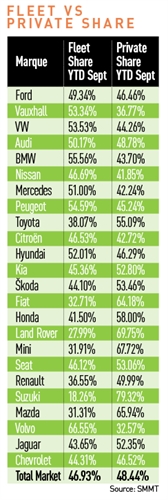By Jay Nagley
The share of a manufacturer’s registrations that goes to the fleet market is a closely watched measure, but we thought it would be interesting to look at both the fleet share and the private share (see table) – the two are not exactly a mirror image of each other because there are other categories, such as business.
 |
||
Jay Nagley was a market analyst at Porsche Cars GB before spending the past 13 years as the head of Redspy Automotive, his own analysis and forecasting consultancy. |
||
The table is in descending order of registrations, with market leader, Ford, at the top. Ford is noteworthy because its fleet share is relatively low and its private share is relatively high, especially by the standards of the major brands. The fact that Ford’s share of fleet registrations is lower than any of the German brands would surprise the average motorist.
Vauxhall’s private registrations second from bottom
Immediately below Ford comes Vauxhall, which has a very different story to tell. Its share of private registrations is the second lowest of any brand in the table. When Ford launched the B-Max, it made a presentation about the new car against its competitors, such as the Nissan Note.
When asked why the Vauxhall Meriva had not been included in the table, the Ford spokesperson said tartly, “The B-Max is a retail car and Vauxhall is not a retail brand.” That was something of an exaggeration, but, as the table shows, not entirely without justification.
The four German brands are, as ever, bunched tightly, although it is notable that Audi is more retail-oriented than parent brand VW. That confounds the general principle that the lower the brand positioning in the VW Group, the higher the share of private registrations – both Škoda and Seat are on 53%. That does suggest the breadth of Audi’s appeal: it is very unusual for a premium brand to have an above-average share of private registrations.
Among the Top 10 brands, the highest proportion of fleet registrations comes from Peugeot, although its private share is broadly average. For a brand strong in small cars (the 107 and 208, for example), that is surprising and a slight warning sign: the new 308 needs to strengthen Peugeot’s position outside the fleet market. Sister brand Citroën is much less fleet-oriented, mostly thanks to the DS3’s strong appeal to private buyers. There is a similar pattern with the Korean brands: parent Hyundai is quite fleet-orientated, but Kia has a considerably higher share of private buyers. One would normally assume that it is easier to grow by increasing fleet registrations than retail ones.
 |
|
The biggest outlier amongst the major brands is Fiat, with a fleet proportion of just 33%. That reflects the fact that Fiat effectively only operates in the A- and B-segment, which are primarily retail sectors. Normally, such a low proportion of fleet registrations would suggest an area where the company could grow, but there are only so many driving schools and urban estate agents that can take Fiat 500s.
Renault’s figure is not so different from Fiat’s, but Renault does have the Mégane and the Scenic, so it has more potential to grow fleet registrations as it tries to recover from the drastic pruning of its range two years ago.
The one company that definitely can grow fleet registrations is Honda, which has been damaged in this sector by its lack of a competitive diesel engine. Until this year, Honda only had a 2.2-litre diesel, which effectively excluded it from the fleet market for lower-medium cars. With its new 1.6-litre diesel, it can start to recover lost ground. Another potential recovery stock is Mazda. With its Japan-only factories, the high yen made it hard for Mazda to offer keen deals in recent years. However, now that the yen has declined, Mazda has a chance to grow its fleet business.
Jaguar desperate to increase fleet registrations
A brand rather closer to home desperate to increase fleet registrations is Jaguar. In its case, having the lowest proportion in the premium saloon sector is not a sign of strength, but of government chopping it off at the knees.
When the government suddenly reduced the tax write-off limit from 160g/km to 130g/km of CO2, it seemed unaware that the XF started at 133 g/km. For the 2014 model year, the Jaguar figure will be below the important 130g/km barrier, so Jaguar can start trying to close the gap on the Germans in the four-cylinder executive segment.
Finally, what of the brand with the lowest proportion of private registrations – Volvo? The V40 has the potential to be a strong retail car (as does the proposed XC40 crossover) and Volvo needs to build on that. Fortunately, it does not have an image of being a fleet brand, and it needs to avoid acquiring one. No premium brand, or in Volvo’s case semi-premium, can afford to be tarred with that brush: Saab illustrates the descending spiral that takes over when a once-premium brand loses retail credibility.














Login to comment
Comments
No comments have been made yet.